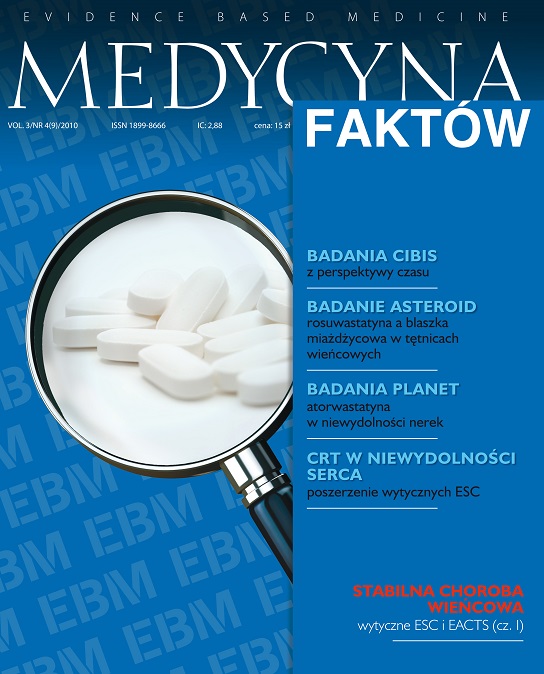Rola statyn w zapobieganiu chorobie Alzheimera i jej leczeniu Artykuł przeglądowy
##plugins.themes.bootstrap3.article.main##
Abstrakt
Wraz ze wzrastającą średnią długością życia coraz większym problemem społecznym stają się choroby przewlekłe, w tym również neurodegeneracyjne. Schorzeniem z tej grupy, które budzi szczególny lęk, jest choroba Alzheimera. Stosowane obecnie leki są w stanie jedynie opóźnić progresję choroby, dlatego ciągle poszukuje się nowych metod farmakoterapii. Jedną z rozważanych możliwości jest wykorzystanie plejotropizmu statyn w prewencji choroby Alzheimera i jej leczeniu. Autorzy artykułu omawiają patofizjologiczne mechanizmy, które mogą odpowiadać za neuroprotekcyjne działanie tej grupy leków. Dokonują również krótkiego przeglądu badań dotyczących tego zagadnienia.
##plugins.themes.bootstrap3.article.details##
Jak cytować
Wełnicki , M., & Mamcarz , A. (2010). Rola statyn w zapobieganiu chorobie Alzheimera i jej leczeniu . Medycyna Faktów , 3(4(9), 72-75. Pobrano z https://journalsmededu.pl/index.php/jebm/article/view/2566
Numer
Dział
Artykuły
Copyright © by Medical Education. All rights reserved.
Bibliografia
1. Foroncewicz B., Mucha K., Pączek L.: Starzenie się a układ odpornościowy. W: Geriatria – wybrane zagadnienia. Galus K. (red.). Elsevier Urban & Partner, Wrocław 2007: 9-14.
2. Pawełczyk T., Kłoszewska I.: Czy statyny znajdują zastosowanie w chorobie Alzheimera? Postępy Psychiatrii i Neurologii 2005; 14(3): 209-216.
3. Jick H., Zornberg G.L., Jick S.S., Seshadri S., Drachman D.A.: Statins and the risk of dementia. Lancet 2000; 356(9242): 1627-31.
4. Rockwood K., Kirkland S., Hogan D.B., MacKnight C., Merry H., Verreault R., Wolfson C., McDowell I.: Use of lipid-lowering agents, indication bias, and the risk of dementia in community-dwelling elderly people. Arch. Neurol. 2002; 59(2): 223-7.
5. Hajjar I., Schumpert J., Hirth V., Wieland D., Eleazer G.P.: The impact of the use of statins on the prevalence of dementia and the progression of cognitive impairment. J. Gerontol. A Biol. Sci. Med. Sci. 2002; 57(7): M414-8.
6. McNaull B.B.A., Todd S., McGuinness B., Passmore A.P.: Inflammation and Anti-Inflammatory Strategies for Alzheimer’s Disease – A Mini-Review.Gerontology 2010; 56: 3-14.
7. Galus R., Zandecki Ł., Jóźwiak J., Włodarski K.: Pozalipidowe działanie statyn. Pol. Merk. Lek. 2008; XXIV (144): 545.
8. Sparks D.L. et al.: Atorvastatin for the treatment of mild to moderate Alzheimer disease: preliminary results. Arch. Neurol. 2005 May; 62(5):753-7.
9. Feldman H.H. et al.; On behalf of the LEADe Investigators: Randomized controlled trial of atorvastatin in mild to moderate Alzheimer disease. LEADe. Neurology [online: doi:10.1212/WNL.0b013e3181d6476a].
2. Pawełczyk T., Kłoszewska I.: Czy statyny znajdują zastosowanie w chorobie Alzheimera? Postępy Psychiatrii i Neurologii 2005; 14(3): 209-216.
3. Jick H., Zornberg G.L., Jick S.S., Seshadri S., Drachman D.A.: Statins and the risk of dementia. Lancet 2000; 356(9242): 1627-31.
4. Rockwood K., Kirkland S., Hogan D.B., MacKnight C., Merry H., Verreault R., Wolfson C., McDowell I.: Use of lipid-lowering agents, indication bias, and the risk of dementia in community-dwelling elderly people. Arch. Neurol. 2002; 59(2): 223-7.
5. Hajjar I., Schumpert J., Hirth V., Wieland D., Eleazer G.P.: The impact of the use of statins on the prevalence of dementia and the progression of cognitive impairment. J. Gerontol. A Biol. Sci. Med. Sci. 2002; 57(7): M414-8.
6. McNaull B.B.A., Todd S., McGuinness B., Passmore A.P.: Inflammation and Anti-Inflammatory Strategies for Alzheimer’s Disease – A Mini-Review.Gerontology 2010; 56: 3-14.
7. Galus R., Zandecki Ł., Jóźwiak J., Włodarski K.: Pozalipidowe działanie statyn. Pol. Merk. Lek. 2008; XXIV (144): 545.
8. Sparks D.L. et al.: Atorvastatin for the treatment of mild to moderate Alzheimer disease: preliminary results. Arch. Neurol. 2005 May; 62(5):753-7.
9. Feldman H.H. et al.; On behalf of the LEADe Investigators: Randomized controlled trial of atorvastatin in mild to moderate Alzheimer disease. LEADe. Neurology [online: doi:10.1212/WNL.0b013e3181d6476a].
